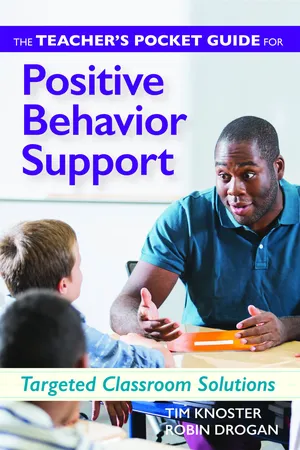
- 160 pages
- English
- ePUB (mobile friendly)
- Available on iOS & Android
The Teacher's Pocket Guide for Positive Behavior Support
About This Book
What should teachers do when universal Tier 1 behavior supports don't sufficiently meet the needs of all children? Next steps can be tricky to navigate when students appear at risk for developing recurring problem behavior—and that's why every teacher needs this concise, strategy-packed guidebook on targeted behavior intervention and support.
Authors Tim Knoster and Robin Drogan are in-demand experts with a combined 50 years of experience training teachers in positive behavior support in the classroom. Together, they bring you a friendly, encouraging guide to Tier 2 positive behavior support, ready to use in schools with or without an existing PBIS system. Brimming with down-to-earth advice, proven strategies, and relatable anecdotes, this book will get you ready to further prevent behavior challenges and create a safe, positive learning environment for each student in your class.
DISCOVER HOW TO:
- Determine which students will benefit from targeted behavior supports
- Choose formal and informal targeted supports that meet each student's needs
- Make the most of targeted supports already available if your school uses PBIS
- Organize and develop Tier 2 supports on your own if your school doesn't currently implement PBIS
- Strengthen your interventions through effective data collection and analysis
- Fade out or step up the intensity of interventions and supports when necessary
- Recognize when students need more intensive, individualized Tier 3 supports
PRACTICAL MATERIALS: Case stories in each chapter that illustrate different behavior supports in action, sample Behavior Contracts and Good Behavior Charts, an at-a-glance guide to social-emotional screeners, quick-reference charts on the features and uses of specific supports, and more
Frequently asked questions
Information
1
How Are Targeted Supports Different from Universal Supports, and Which Students Will Benefit from Them?
STARTING WITH A FIRM FOUNDATION OF UNIVERSAL APPROACHES
| Universal practice | Brief description of the universal practice |
| Building rapport (staying close) | The teacher’s actions result in each student trusting that the teacher has a genuine interest in him or her as a person. The teacher’s behaviors result in a constructive student–teacher relationship that is based on trust and mutual respect. |
| Establishing/teaching performance expectations | The teacher and the students in the classroom together identify three to five broad expectations (e.g., be responsible, be respectful, be here/be ready) and, in turn, create positively stated operational definitions that reflect what students would look/sound like in meeting the expectations across pivotal contexts in the classroom. Once the expectations are established, direct instruction is provided to the students through simulations, with periodic booster sessions over the course of the school year. |
| Positive reinforcement (behavior-specific praise) | The teacher’s presentation of a desired stimulus (e.g., verbal praise in the instance where the student finds verbal praise rewarding) is contingent on the student(s) acting in a manner that is expected (e.g., the student raising his or her hand to gain the teacher’s attention in the classroom). The delivery of the reinforcer (e.g., verbal praise) is explicitly labeled in connection to the behavior that is being reinforced (e.g., “Nice job of raising your hand, Sam. How can I help you?”). |
| Achieving the 4:1 ratio | The teacher, through his or her distribution of positive reinforcement for desired behavior in relation to corrective feedback in response to student problem behavior (misbehavior that requires direct intervention), achieves a ratio of four positive reinforcements for desired behavior to each instance of redirection for problem behavior (thus, the 4:1 ratio). This ratio should ideally be achieved with both the class (in aggregate) and each individual student in the classroom. |
WHAT ARE UNIVERSAL (TIER 1) SUPPORTS, AND WHO ARE THEY FOR?
Establishing Rapport
Setting Clear Expectations
Reinforcing Positive Behavior
WHERE THIS BOOK COMES IN: STUDENTS WHO NEED MORE SUPPORT
Table of contents
- Cover
- Title Page
- Copyright
- Contents
- About the Downloadable Materials
- About the Authors
- Preface
- 1. How Are Targeted Supports Different from Universal Supports, and Which Students Will Benefit from Them?
- 2. What Is Targeted Support, and What Does It Mean to Provide Such Support in the Classroom?
- 3. How Do I Gather Practical Information on Student Behavior in My Classroom?
- 4. What Do Targeted Supports Look Like in a School Using PBIS?
- 5. What Do Targeted Supports Look Like in a Classroom in a Traditional School?
- 6. How Do You Adjust Targeted Supports Based On Student Progress?
- 7. How Do Targeted Supports Relate to Individualized Intensive Supports?
- References
- Appendix Blank Forms
- Resources
- Index